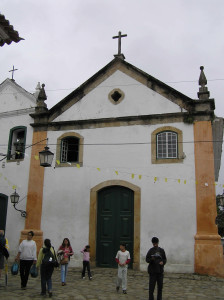Written by Marco Ramerini. English text revision by Dietrich Köster.
The main attraction of Paraty is its historic center with beautifully preserved colonial architecture. It is a day trip from the city of Rio de Janeiro. The distance is 240 km and it takes 4 hours to reach Paraty with a car along the beautiful coast of the Costa Verde, where along the road the mountains reach the sea, and there are hundreds of islands, including Ilha Grande at the Restinga de Marambaia, and important touristic centers as Angra dos Reis. If you can stay there for a few days, the bay of Paraty offers you a tropical forest, more than 60 islands, 300 beaches and unforgettable marine sceneries.
Paraty was an important center in the colonial period. During the XVIIIth century its port was used to take the discovered gold of Minas Gerais to Rio de Janeiro, and also the coffee produced in the Vale do Paraíba. With the railroad construction between São Paulo and Rio de Janeiro at the end of the XIXth century the city fell into a sleeping beauty. There is nothing better in Paraty than walking in the streets with about 30 quarters in the historical center with a lot of buildings from the XIXth and XVIIIth centuries. It still keeps the original pavement and vehicles are not allowed to enter.

The construction of the matriz church N.S. dos Remédios is linked to an interesting story. In 1646 a lady called Maria Jácome de Melo donated the land for the construction of the village of Paraty, but she set two conditions: first the building of a chapel dedicated to Nossa Senhora dos Remédios and second that nobody would harm the Indians, who lived there. The chapel was built, but in 1668 was demolished and a new one was built. It was finished in 1712. In 1787 the population amounted to 2.700 people and the church was too small. Thus a new church was started to build and its construction took nearly 90 years (1787-1873). It is the actual church.
You should also visit the Igreja de Santa Rita, located in front of the sea. This church was built in 1722 and is the oldest church of Paraty. It was used by the white élite of the town. Inside this church is the Museu de Arte Sacra (Sacred Art Museum) de Paraty. Another old church is the Igreja de Nossa Senhora do Rosário e São Benedito. The construction of this church was started in 1725. It was meant for the black slaves, who helped building it. Generally speaking in this town the Brazilian colonial style of the big houses and second floors are well preserved and houses inns, restaurants and craftwork stores. There are also many plastic artists’ ateliers.
On a hill overlooking Paraty is situated the Forte Defensor Perpétuo. This fort was built in 1703. The fortification system of Paraty was composed of six more fortifications: da Ponta Grossa, da Ilha das Bexigas, de Iticopê, da Patitiba, da Ilha do Mantimento e da Bateria do Quartel.








